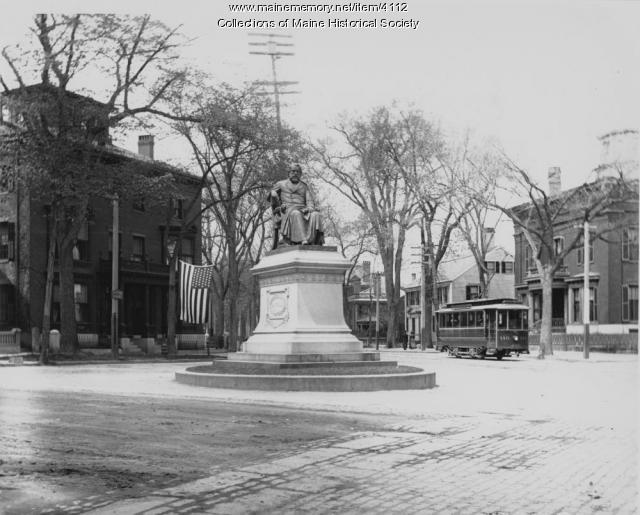Keywords: Native americans
Item 7543
Native American grooved axe head, ca. 1000
Contributed by: Maine Historical Society Date: circa 1000 Location: Newcastle Media: Stone
Item 23488
Native American snowshoe, ca. 1900
Contributed by: Hudson Museum, Univ. of Maine Date: 1900 Media: Wood, leather
Item 110473
Stonecroft pool and service court, Falmouth, 1999-2001
Contributed by: Maine Historical Society Date: 1999–2001 Location: Falmouth Clients: Tom Tureen; Susan Tureen Architect: Patrick Chasse; Landscape Design Associates
Item 111491
Isaacson residence floor plan and presentation drawing, Lewiston, 1960
Contributed by: Maine Historical Society Date: 1960 Location: Lewiston Client: Philip Isaacson Architect: F. Frederick Bruck; F. Frederick Bruck, Architect
Exhibit
"Twenty Nationalities, But All Americans"
Concern about immigrants and their loyalty in the post World War I era led to programs to "Americanize" them -- an effort to help them learn English and otherwise adjust to life in the United States. Clara Soule ran one such program for the Portland Public Schools, hoping it would help the immigrants be accepted.
Exhibit
When Europeans arrived in North America and disrupted traditional Native American patterns of life, they also offered other opportunities: trade goods for furs. The fur trade had mixed results for the Wabanaki.
Site Page
Presque Isle: The Star City - Native Americans
"… Native Americans The Deep History of Presque Isle Text by: David Putnam In 1978, as a result of the proposal to construct the Aroostook Centre…"
Site Page
Biddeford History & Heritage Project - RESOURCES
"(T) "A Timeline of Native American Culture." Home: The story of Maine. Maine Public Broadcasting Network. Web. 1 Jan 2010."
Story
Where are the French?
by Rhea Côté Robbins
Franco-Americans in Maine
Story
Alex Mouzas: Passionate about sharing his Greek-American roots
by Biddeford Cultural & Heritage Center
A personal, in-depth look into the life and contributions of area Greek-Americans
Lesson Plan
Grade Level: 3-5, 6-8, 9-12
Content Area: Science & Engineering, Social Studies
This lesson plan will give middle and high school students a broad overview of the ash tree population in North America, the Emerald Ash Borer (EAB) threatening it, and the importance of the ash tree to the Wabanaki people in Maine. Students will look at Wabanaki oral histories as well as the geological/glacial beginnings of the region we now know as Maine for a general understanding of how the ash tree came to be a significant part of Wabanaki cultural history and environmental history in Maine. Students will compare national measures to combat the EAB to the Wabanaki-led Ash Task Force’s approaches in Maine, will discuss the benefits and challenges of biological control of invasive species, the concept of climigration, the concepts of Traditional Ecological Knowledge (TEK) and Indigenous Knowledge (IK) and how research scientists arrive at best practices for aiding the environment.
Lesson Plan
Maine's Acadian Community: "Evangeline," Le Grand Dérangement, and Cultural Survival
Grade Level: 9-12
Content Area: English Language Arts, Social Studies
This lesson plan will introduce students to the history of the forced expulsion of thousands of people from Acadia, the Romantic look back at the tragedy in Henry Wadsworth Longfellow's famous epic poem Evangeline and the heroine's adoption as an Acadian cultural figure, and Maine's Acadian community today, along with their relations with Acadian New Brunswick and Nova Scotia residents and others in the Acadian Diaspora. Students will read and discuss primary documents, compare and contrast Le Grand Dérangement to other forced expulsions in Maine history and discuss the significance of cultural survival amidst hardships brought on by treaties, wars, and legislation.


















